Thermal Analysis Strategy for Axial Permanent Magnet Coupling Combining FEM with Lumped-Parameter Thermal Network
Abstract
:1. Introduction
2. Geometry of the Studied APMC
3. Proposed Strategy and Assumptions
3.1. Proposed Strategy
3.2. Assumptions
- From Figure 2, the geometry of the APMC is approximatively centrosymmetric. Also, the parameters of every component along the circumferential direction (r) were uniform. Therefore, the loss and temperature distributions were centrosymmetric as well.
- The APMC operated in the steady-state with a certain slip speed (s), so it is reasonable to think the air in the air-gap as stable, whereby the temperature distribution in the air-gap was also the same.
- Considering the skin effect, the loss is mainly concentrated upon the CS, and other losses, were ignored.
4. Magnetic Field Model
4.1. Key Considerations
4.2. Analysis of Magnetic Field on the CS
4.3. Loss Calculation
5. LPTN Model
5.1. LPTN Model
5.2. Calculation for Thermal Resistances
- Conduction heat transfer: The region not in contact with air belongs to conduction heat transfer, as follows: inside the iron yoke (R1~14, R1~21, R7~8 and R7~15); inside the CS (R2~13 and R2~20); between the iron yoke and the CS (R1~2, R13~14 and R20~21); inside the PM holder (R4~11, R4~18, R9~10, R10~11, R16~17 and R17~18); between the PM and the PM holder (R4~5, R5~10, R5~17, R6~9 and R6~16); inside the PM (R5~6); between the PM and the iron yoke (R6~7); between the PM holder and the iron yoke (R8~9 and R15~16). Conduction thermal resistances can be obtained as [23,29]where L (m) is the transfer path length, k (W/(m·°C) is the thermal conductivity of the material and A (m2) is the transfer path area. Here, Table 2 presents the thermal conductivity of the materials.
- 2.
- Equivalent conduction/convection heat transfer: Since it is difficult to determine the flow condition in the air-gap, the air in the air gap can be regarded as a solid for convenience of calculation, that is, the convection heat transfer phenomenon in the air-gap can be simulated with a given air gap equivalent thermal conductivity. For the air-gap, corresponding to node 3, the equivalent heat transfer coefficient (hair) can be calculated empirically aswhere vair is the airflow velocity in the air gap, Reair is the Reynolds number for the air-gap and γ is the kinematic viscosity of air.
- 3.
- Convection heat transfer: In Figure 12, convection heat transfer certainly occurs between ambient node 0 and other nodes. Generally, as fluid flows, natural convection or forced convection would occur. The former is caused by the nonuniformity of the temperature or concentration; the latter relies on an external force, such as a pump or fan. For the studied APMC, although there is no pump or fan, the heat transfer belongs to forced convection because of the rotational motion of the CS and the PM holder. Convection thermal resistances can be obtained as [29]where h (W/(m·°C)) is the convection heat transfer coefficient, and A (m2) is the transfer path area.
5.3. Calculation for Temperature Rise
5.4. Adjusting the Conductivity of the CS
6. Experiment Verification
7. Conclusions
Author Contributions
Funding
Conflicts of Interest
Nomenclature
| nin | rotational speed of the CS module |
| nout | rotational speed of the PM module |
| s | Slip speed (nin − nout) |
| p | pole-pairs number of the PMs |
| li1 | thickness of the iron yoke (CS side) |
| li2 | thickness of the iron yoke (PM side) |
| lcs | thickness of the CS |
| lg | thickness of the air-gap |
| lh | thickness of the PM holder |
| lp | thickness of the PM |
| r1 | inside radius of the CS |
| r2 | outside radius of the CS |
| rp1 | inside radius of the PM |
| rp2 | outside radius of the PM |
| ra | average radius of the PM |
| Hp | coercive force of the PM |
| σcs | conductivity of the CS |
| R, Ri~j | thermal resistance |
| Pcs | loss generated on the CS |
| T, T0 | temperature, ambient temperature |
| τp | length between centers of adjacent PMs |
| τm | length between adjacent PMs |
Appendix A
Appendix B
Appendix C
References
- Ye, L.Z.; Li, D.S.; Ma, Y.J.; Jiao, B.F. Design and Performance of a Water-cooled Permanent Magnet Retarder for Heavy Vehicles. IEEE Trans. Energy Convers. 2011, 26, 953–958. [Google Scholar] [CrossRef]
- Li, Y.B.; Lin, H.Y.; Huang, H.; Yang, H.; Tao, Q.C.; Fang, S.H. Analytical Analysis of a Novel Brushless Hybrid Excited Adjustable Speed Eddy Current Coupling. Energies 2019, 12, 308. [Google Scholar] [CrossRef] [Green Version]
- Mohammadi, S.; Mirsalim, M.; Vaez-Zadeh, S.; Talebi, H.A. Analytical Modeling and Analysis of Axial-Flux Interior Permanent-Magnet Couplers. IEEE Trans. Ind. Electron. 2014, 61, 5940–5947. [Google Scholar] [CrossRef]
- Lubin, T.; Mezani, S.; Rezzoug, A. Simple Analytical Expressions for the Force and Torque of Axial Magnetic Couplings. IEEE Trans. Energy Convers. 2012, 27, 536–546. [Google Scholar] [CrossRef] [Green Version]
- Wang, S.; Guo, Y.C.; Cheng, G.; Li, D.Y. Performance Study of Hybrid Magnetic Coupler Based on Magneto Thermal Coupled Analysis. Energies 2017, 10, 1148. [Google Scholar] [CrossRef] [Green Version]
- Wang, J.; Zhu, J.G. A Simple Method for Performance Prediction of Permanent Magnet Eddy Current Couplings Using a New Magnetic Equivalent Circuit Model. IEEE Trans. Ind. Electron. 2018, 65, 2487–2495. [Google Scholar] [CrossRef]
- Dai, X.; Liang, Q.H.; Cao, J.Y.; Long, Y.J.; Mo, J.Q.; Wang, S.G. Analytical Modeling of Axial-Flux Permanent Magnet Eddy Current Couplings With a Slotted Conductor Topology. IEEE Trans. Magn. 2016, 52, 15. [Google Scholar] [CrossRef]
- Lubin, T.; Mezani, S.; Rezzoug, A. Experimental and Theoretical Analyses of Axial Magnetic Coupling Under Steady-State and Transient Operations. IEEE Trans. Ind. Electron. 2014, 61, 4356–4365. [Google Scholar] [CrossRef] [Green Version]
- Mohammadi, S.; Mirsalim, M. Double-sided permanent-magnet radial-flux eddy-current couplers: Three-dimensional analytical modelling, static and transient study, and sensitivity analysis. IET Electr. Power Appl. 2013, 7, 665–679. [Google Scholar] [CrossRef]
- Ravaud, R.; Lemarquand, V.; Lemarquand, G. Analytical Design of Permanent Magnet Radial Couplings. IEEE Trans. Magn. 2010, 46, 3860–3865. [Google Scholar] [CrossRef]
- Mohammadi, S.; Mirsalim, M.; Vaez-Zadeh, S. Nonlinear Modeling of Eddy-Current Couplers. IEEE Trans. Energy Convers. 2014, 29, 224–231. [Google Scholar] [CrossRef]
- Fei, W.Z.; Luk, P.C.K. Torque Ripple Reduction of a Direct-Drive Permanent-Magnet Synchronous Machine by Material-Efficient Axial Pole Pairing. IEEE Trans. Ind. Electron. 2012, 59, 2601–2611. [Google Scholar] [CrossRef] [Green Version]
- Min, K.C.; Choi, J.Y.; Kim, J.M.; Cho, H.W.; Jang, S.M. Eddy-Current Loss Analysis of Noncontact Magnetic Device with Permanent Magnets Based on Analytical Field Calculations. IEEE Trans. Magn. 2015, 51, 4. [Google Scholar] [CrossRef]
- Choi, J.Y.; Jang, S.M. Analytical magnetic torque calculations and experimental testing of radial flux permanent magnet-type eddy current brakes. J. Appl. Phys. 2012, 111, 3. [Google Scholar] [CrossRef]
- Dai, X.; Cao, J.Y.; Long, Y.J.; Liang, Q.H.; Mo, J.Q.; Wang, S.G. Analytical Modeling of an Eddy-current Adjustable-speed Coupling System with a Three-segment Halbach Magnet Array. Electr. Power Compon. Syst. 2015, 43, 1891–1901. [Google Scholar] [CrossRef]
- Wang, J.; Lin, H.Y.; Fang, S.H.; Huang, Y.K. A General Analytical Model of Permanent Magnet Eddy Current Couplings. IEEE Trans. Magn. 2014, 50, 9. [Google Scholar] [CrossRef]
- Lubin, T.; Rezzoug, A. Steady-State and Transient Performance of Axial-Field Eddy-Current Coupling. IEEE Trans. Ind. Electron. 2015, 62, 2287–2296. [Google Scholar] [CrossRef] [Green Version]
- Dolisy, B.; Mezani, S.; Lubin, T.; Leveque, J. A New Analytical Torque Formula for Axial Field Permanent Magnets Coupling. IEEE Trans. Energy Convers. 2015, 30, 892–899. [Google Scholar] [CrossRef] [Green Version]
- Lubin, T.; Rezzoug, A. 3-D Analytical Model for Axial-Flux Eddy-Current Couplings and Brakes Under Steady-State Conditions. IEEE Trans. Magn. 2015, 51, 12. [Google Scholar] [CrossRef] [Green Version]
- Wang, J.; Lin, H.Y.; Fang, S.H. Analytical Prediction of Torque Characteristics of Eddy Current Couplings Having a Quasi-Halbach Magnet Structure. IEEE Trans. Magn. 2016, 52, 9. [Google Scholar] [CrossRef]
- Li, Z.; Wang, D.Z.; Zheng, D.; Yu, L.X. Analytical modeling and analysis of magnetic field and torque for novel axial flux eddy current couplers with PM excitation. AIP Adv. 2017, 7, 13. [Google Scholar] [CrossRef] [Green Version]
- Lubin, T.; Rezzoug, A. Improved 3-D Analytical Model for Axial-Flux Eddy-Current Couplings with Curvature Effects. IEEE Trans. Magn. 2017, 53, 9. [Google Scholar] [CrossRef]
- Huang, X.Z.; Li, L.Y.; Zhou, B.; Zhang, C.M.; Zhang, Z.R. Temperature Calculation for Tubular Linear Motor by the Combination of Thermal Circuit and Temperature Field Method Considering the Linear Motion of Air Gap. IEEE Trans. Ind. Electron. 2014, 61, 3923–3931. [Google Scholar] [CrossRef]
- Lu, Y.P.; Liu, L.; Zhang, D.X. Simulation and Analysis of Thermal Fields of Rotor Multislots for Nonsalient-Pole Motor. IEEE Trans. Ind. Electron. 2015, 62, 7678–7686. [Google Scholar] [CrossRef]
- Vese, I.C.; Marignetti, F.; Radulescu, M.M. Multiphysics Approach to Numerical Modeling of a Permanent-Magnet Tubular Linear Motor. IEEE Trans. Ind. Electron. 2010, 57, 320–326. [Google Scholar] [CrossRef]
- Zhu, X.Y.; Wu, W.Y.; Yang, S.; Xiang, Z.X.; Quan, L. Comparative Design and Analysis of New Type of Flux-Intensifying Interior Permanent Magnet Motors with Different Q-Axis Rotor Flux Barriers. IEEE Trans. Energy Convers. 2018, 33, 2260–2269. [Google Scholar] [CrossRef]
- Le Besnerais, J.; Fasquelle, A.; Hecquet, M.; Pelle, J.; Lanfranchi, V.; Harmand, S.; Brochet, P.; Randria, A. Multiphysics Modeling: Electro-Vibro-Acoustics and Heat Transfer of PWM-Fed Induction Machines. IEEE Trans. Ind. Electron. 2010, 57, 1279–1287. [Google Scholar] [CrossRef]
- Sun, X.K.; Cheng, M. Thermal Analysis and Cooling System Design of Dual Mechanical Port Machine for Wind Power Application. IEEE Trans. Ind. Electron. 2013, 60, 1724–1733. [Google Scholar] [CrossRef]
- Mo, L.H.; Zhang, T.; Lu, Q. Thermal Analysis of a Flux-Switching Permanent-Magnet Double-Rotor Machine with a 3-D Thermal Network Model. IEEE Trans. Appl. Supercond. 2019, 29, 5. [Google Scholar] [CrossRef]
- Valenzuela, M.A.; Ramirez, G. Thermal Models for Online Detection of Pulp Obstructing the Cooling System of TEFC Induction Motors in Pulp Area. IEEE Trans. Ind. Appl. 2011, 47, 719–729. [Google Scholar] [CrossRef]
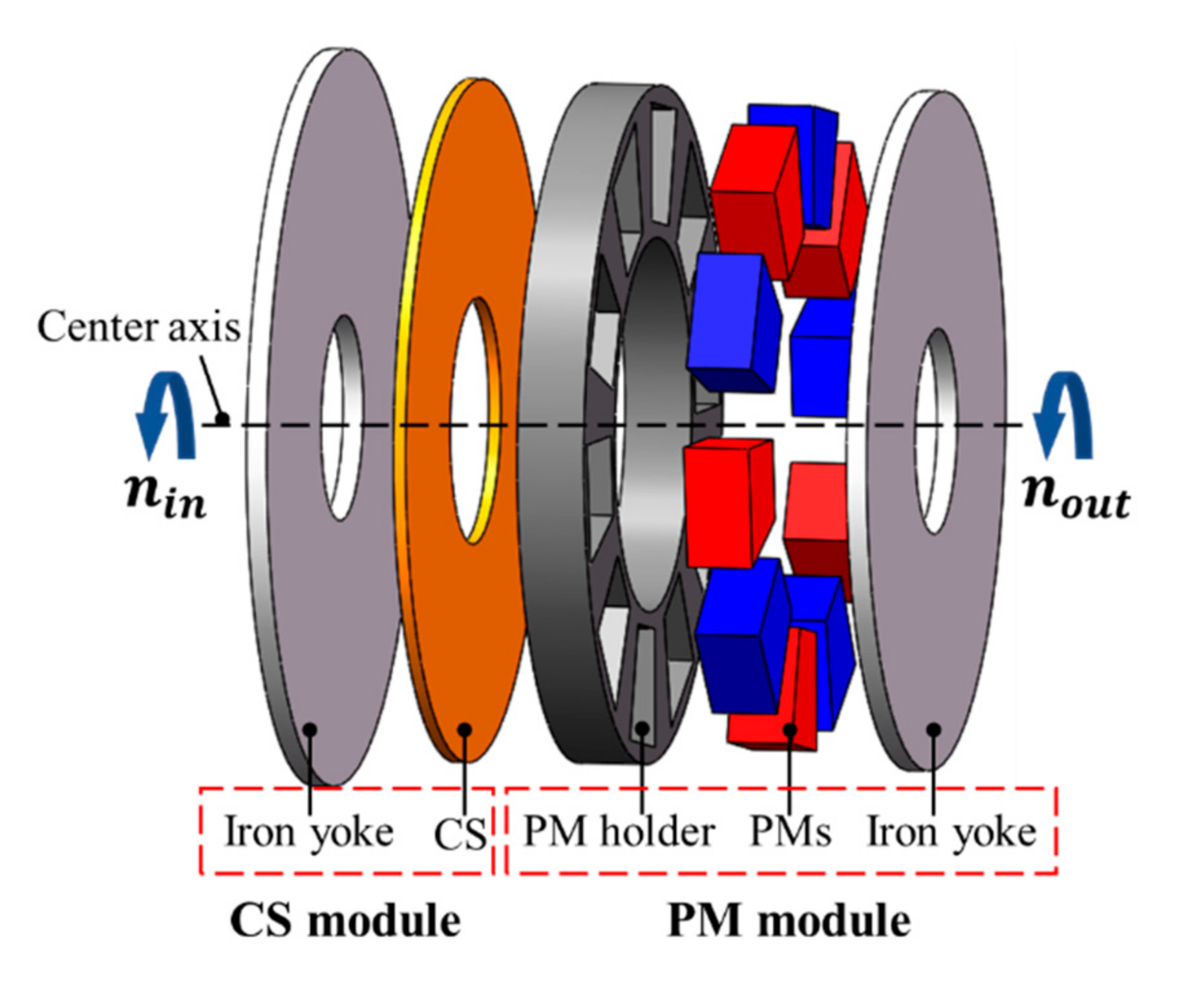
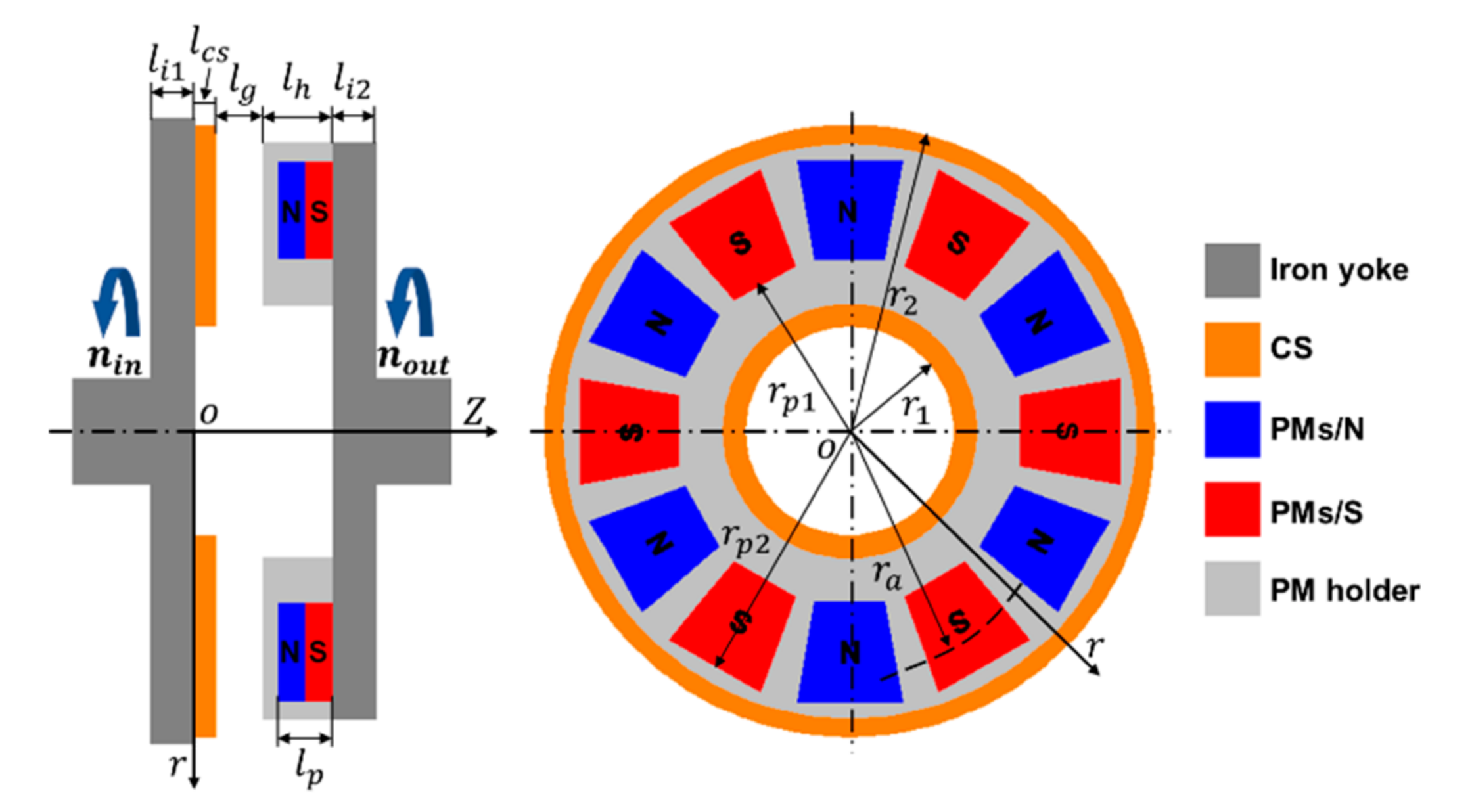

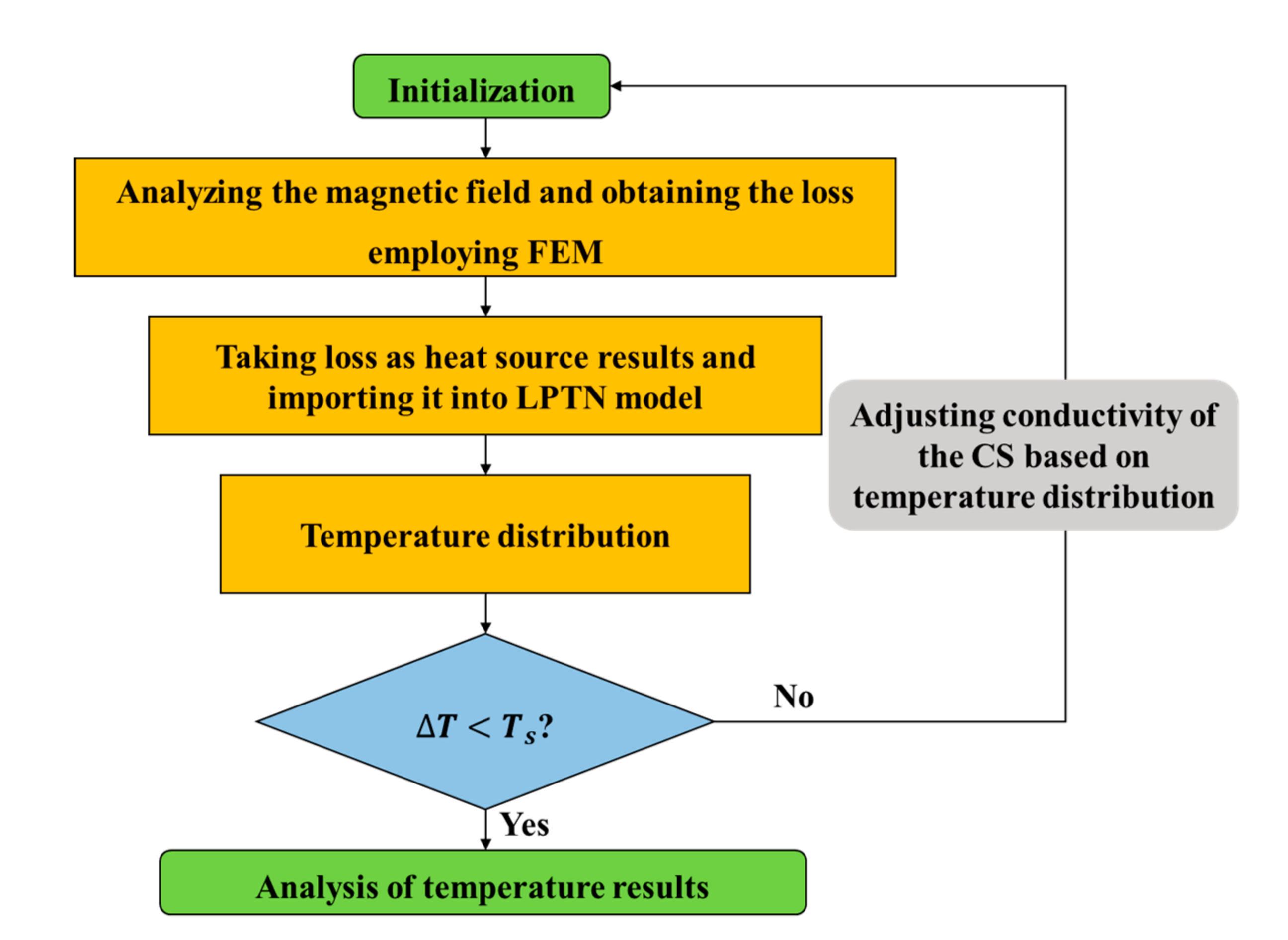
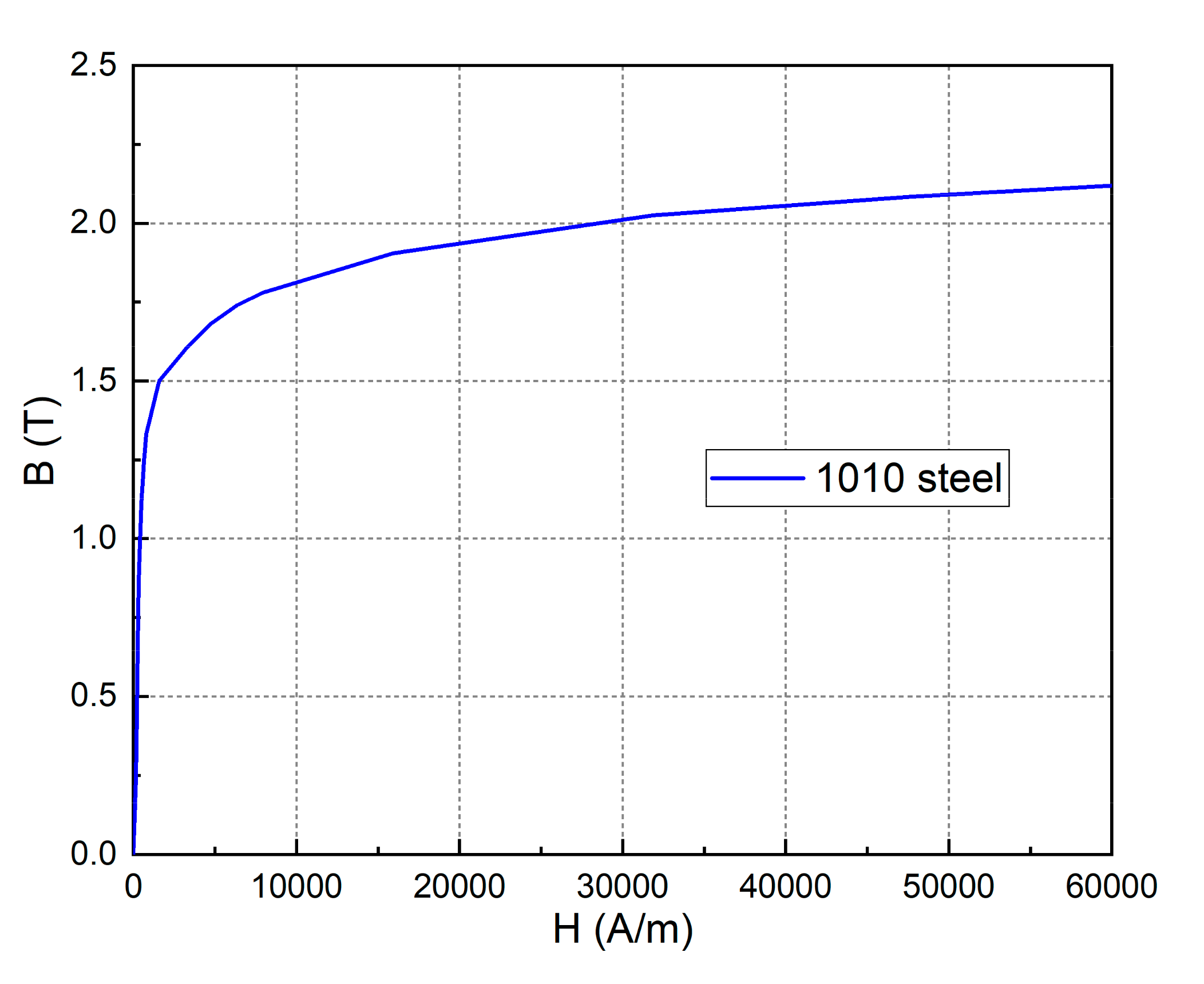
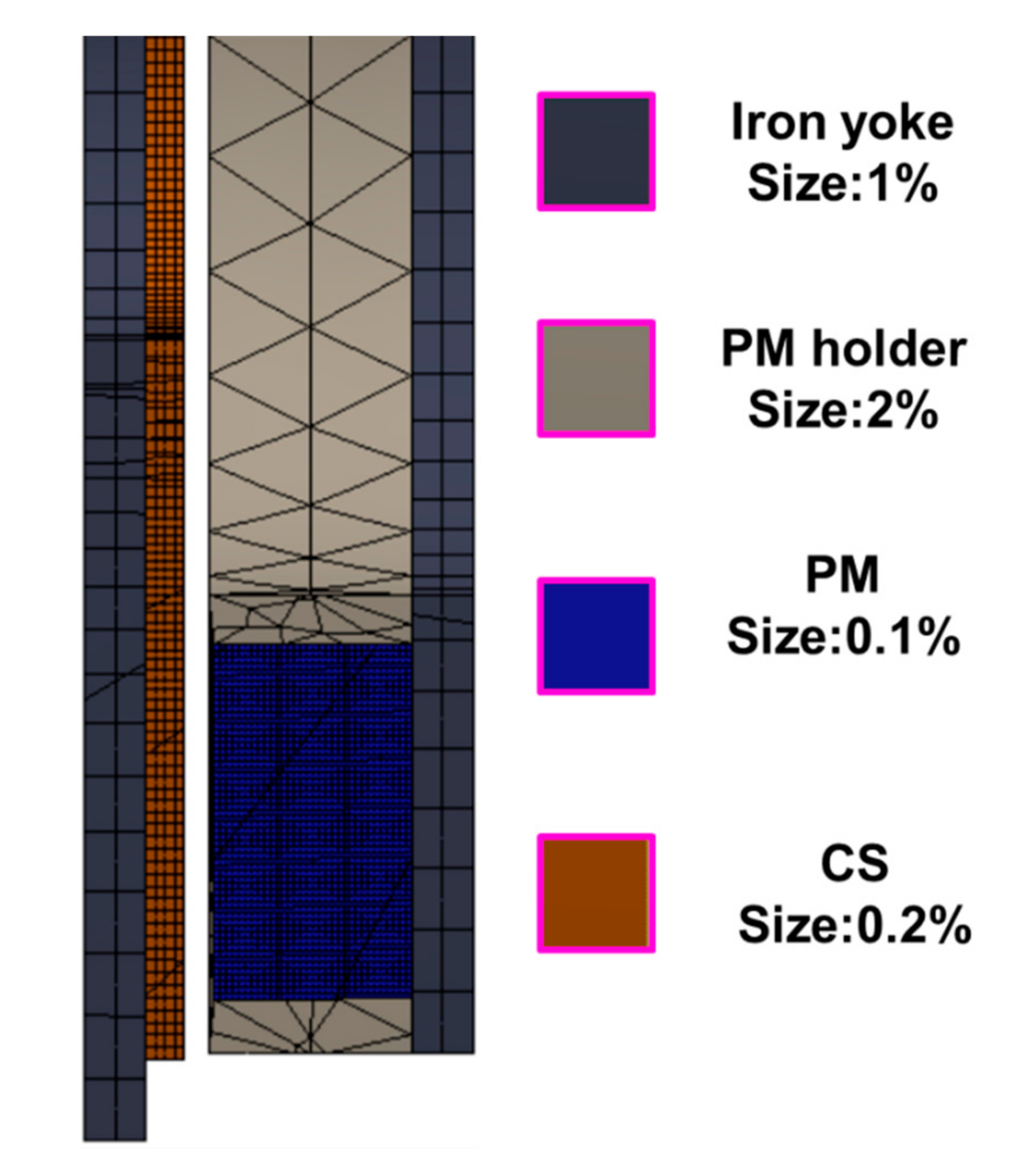
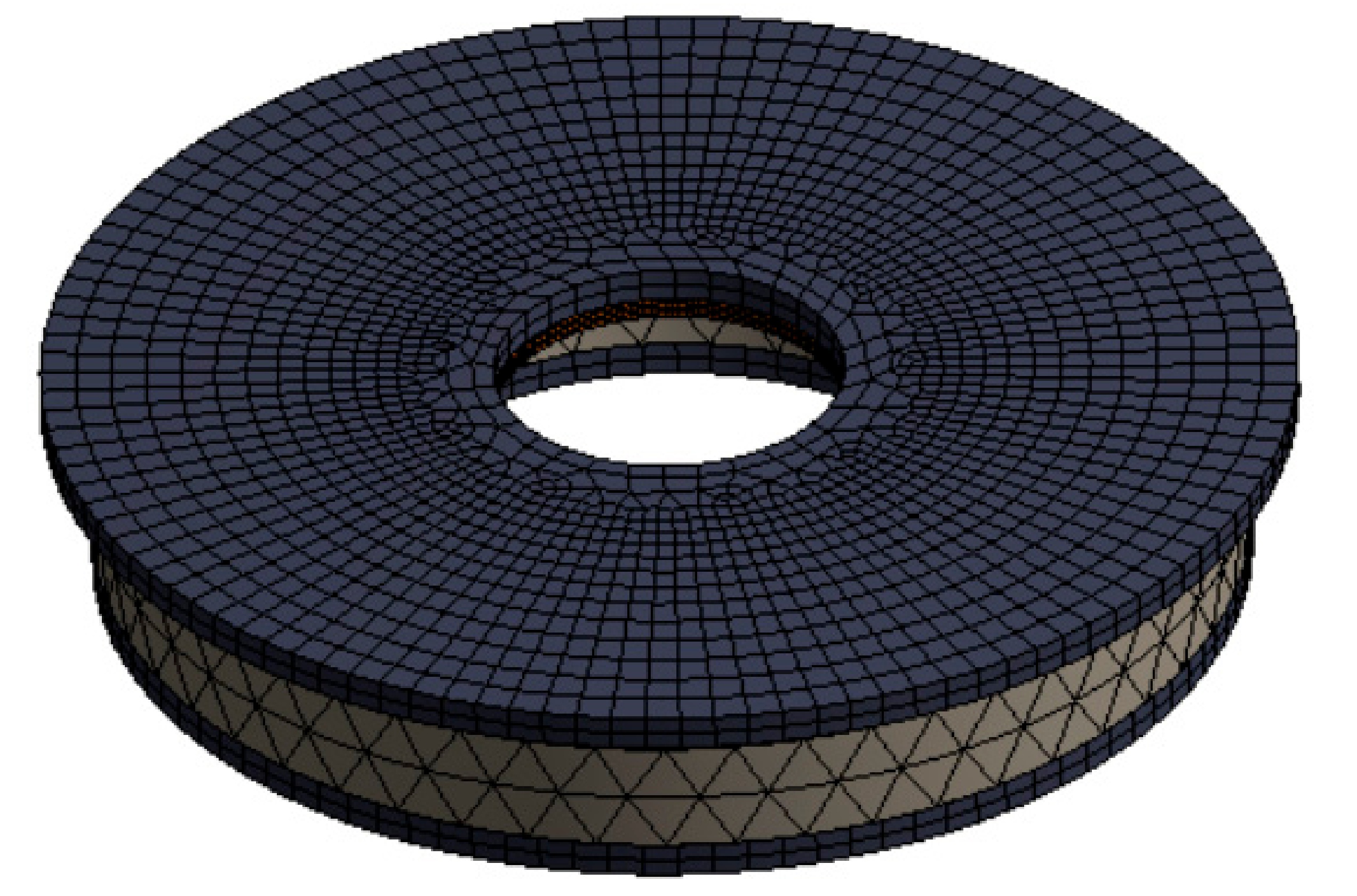

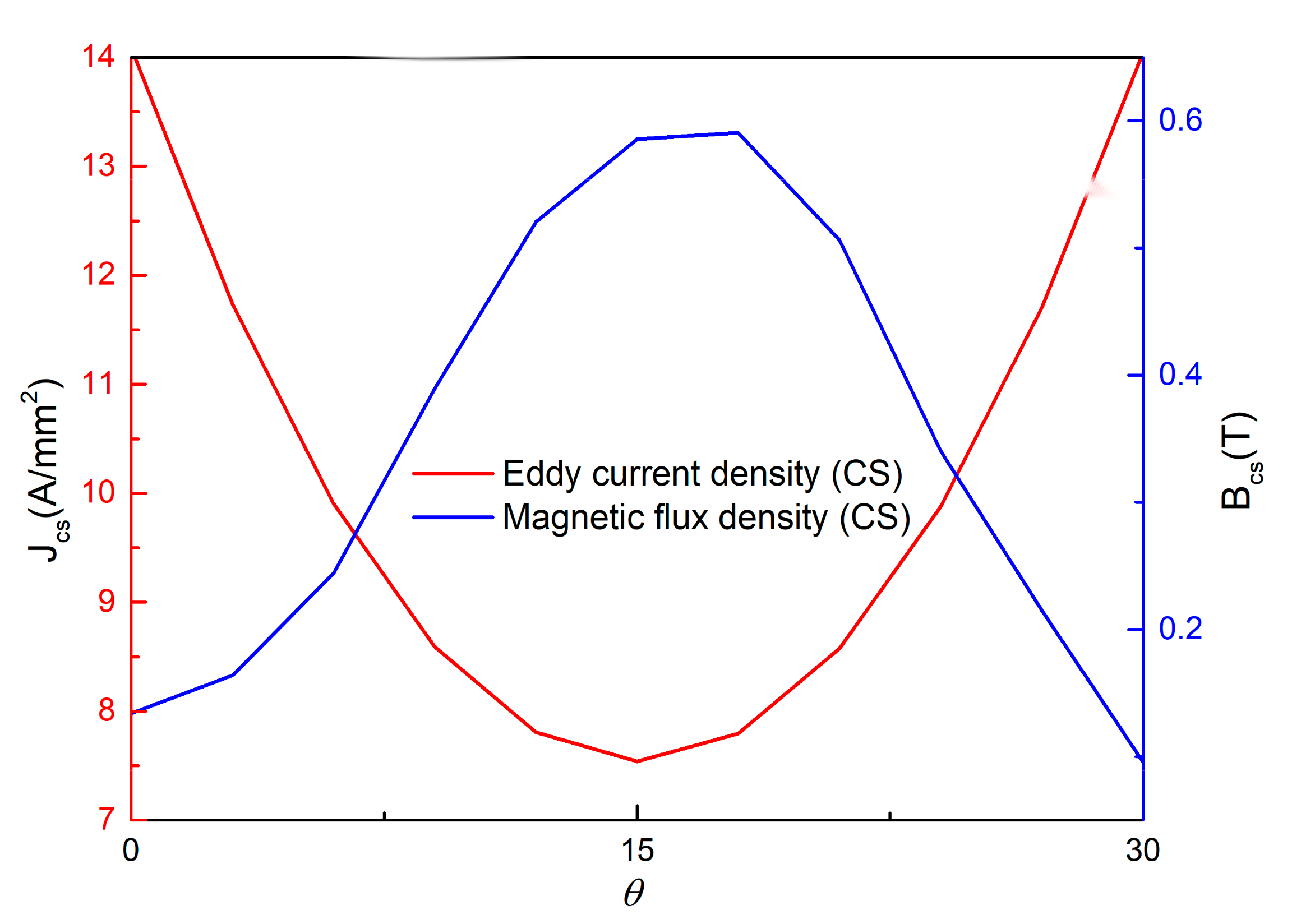
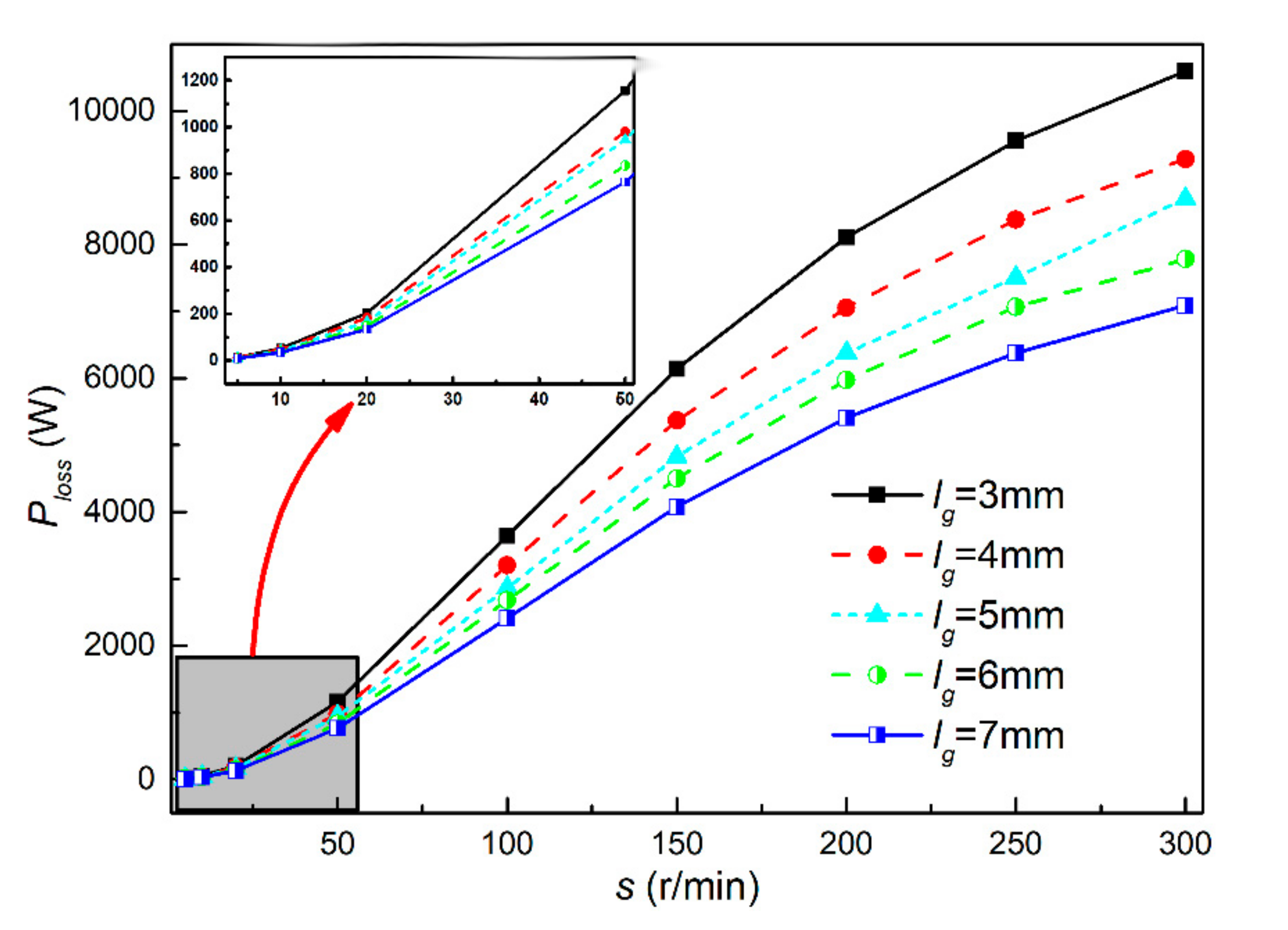
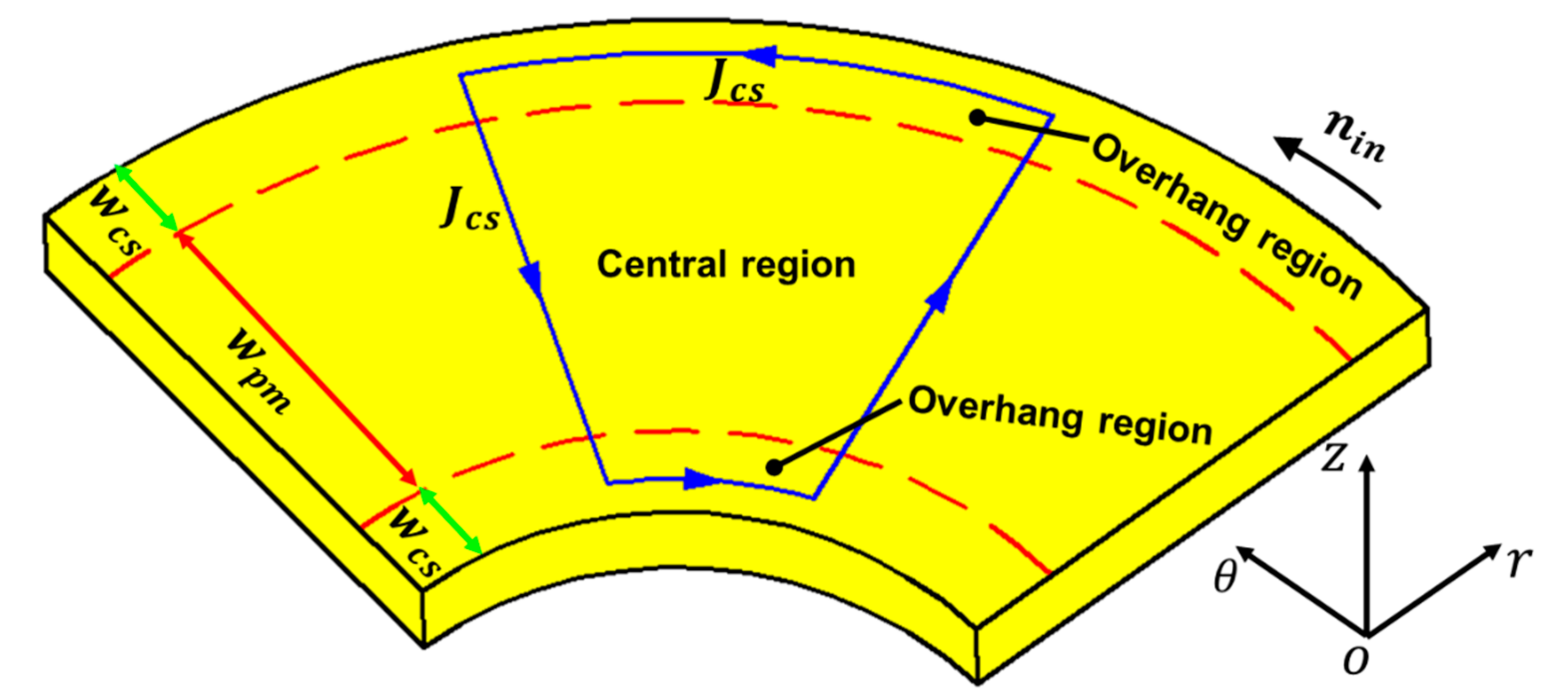

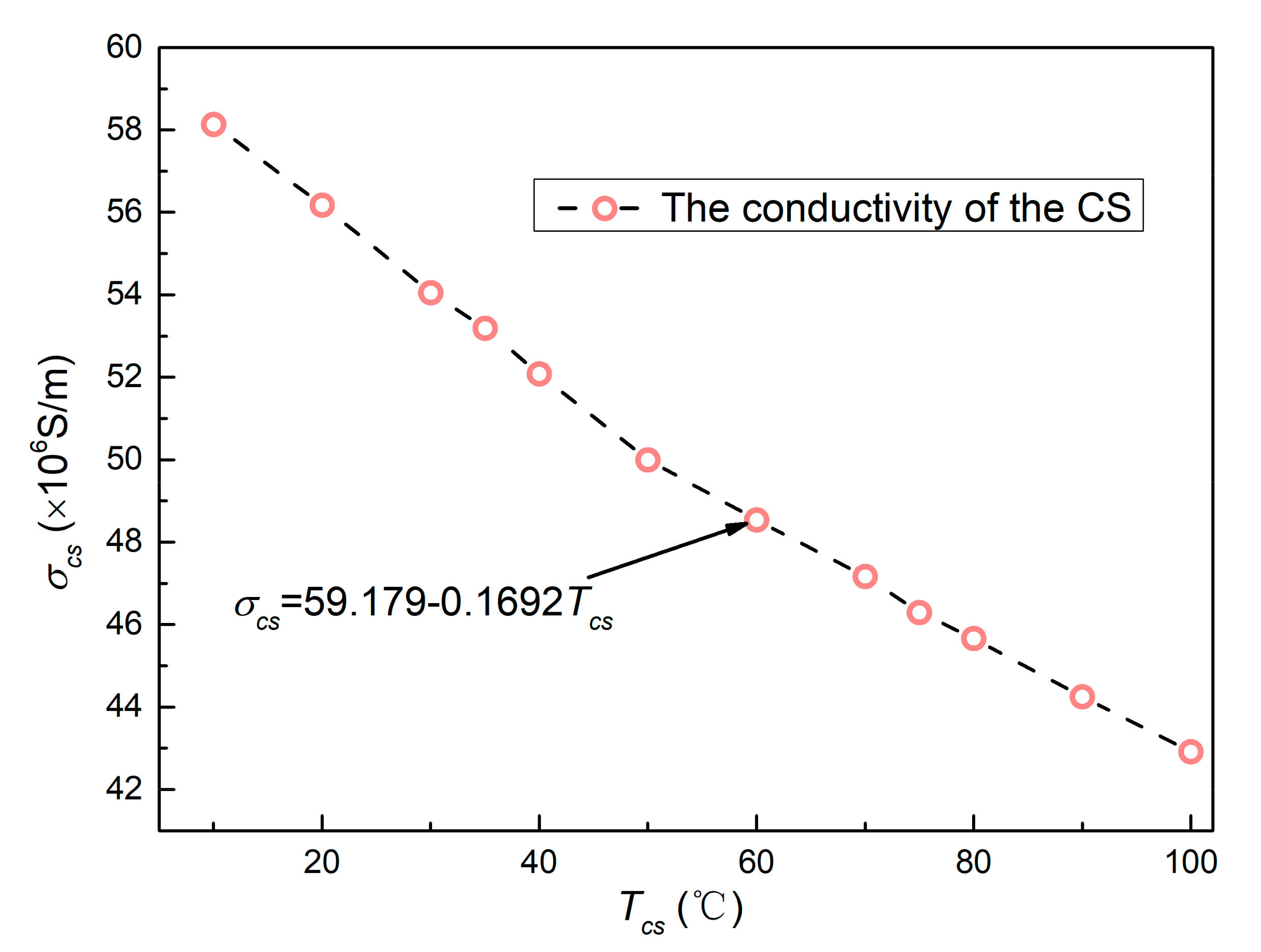
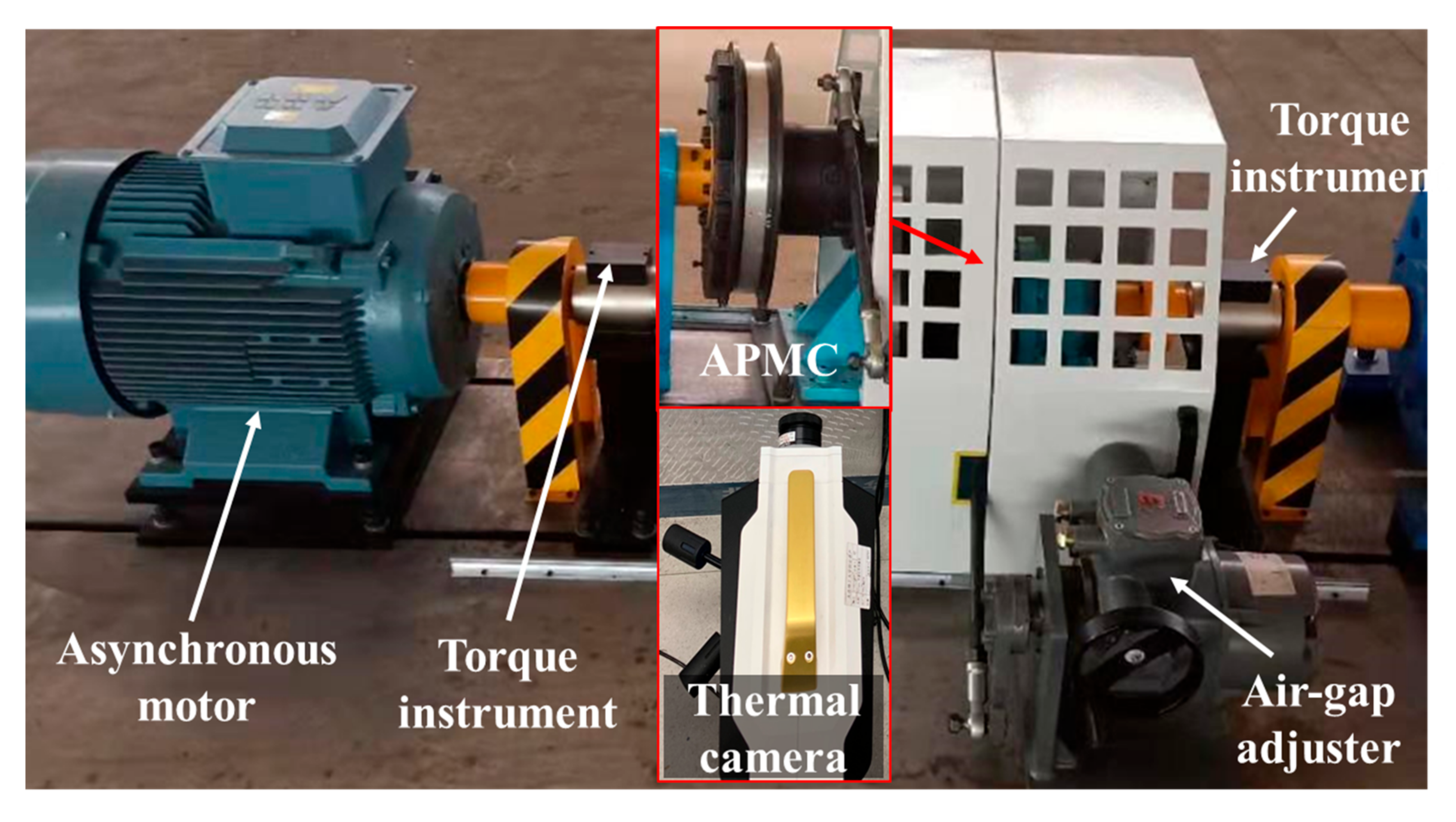
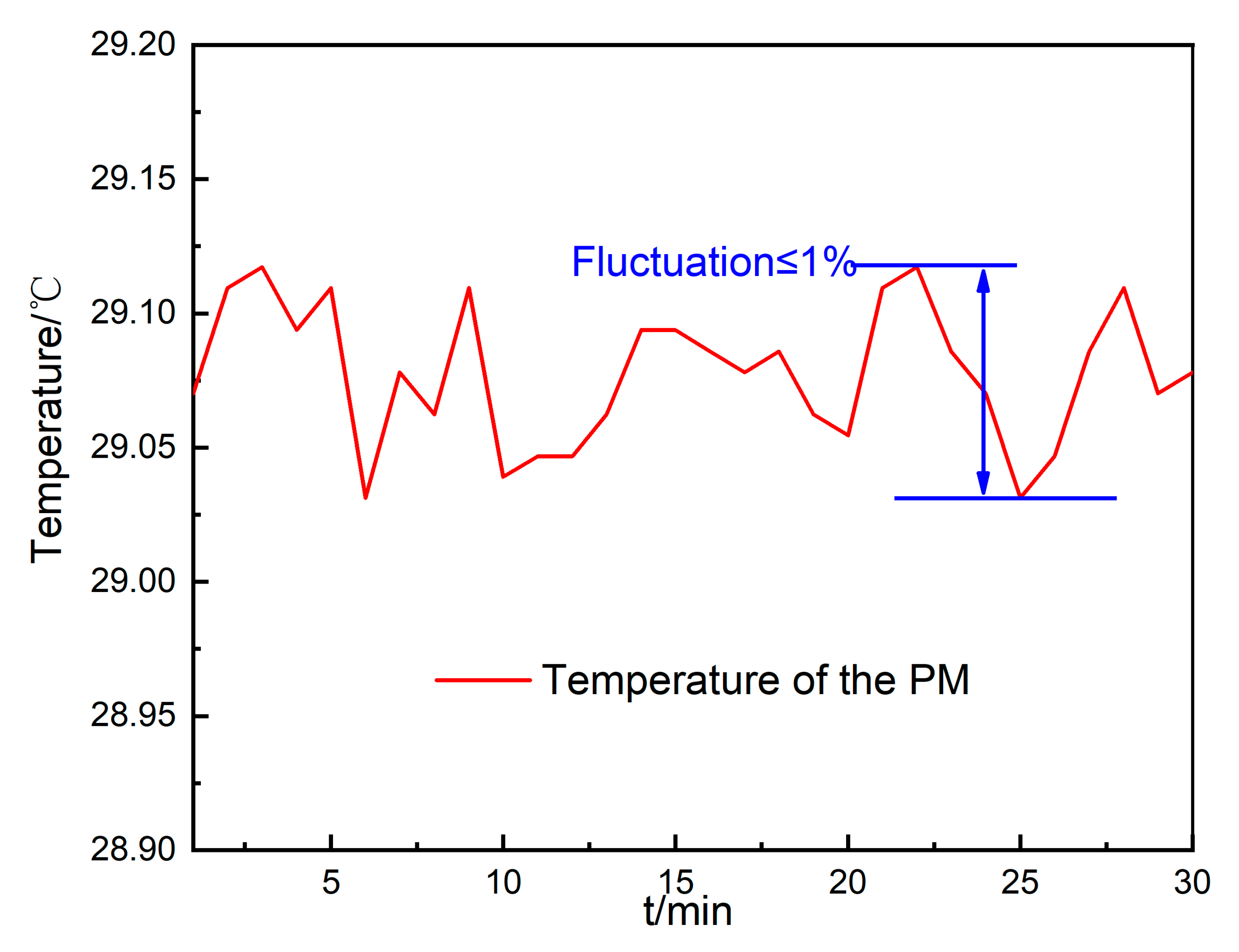

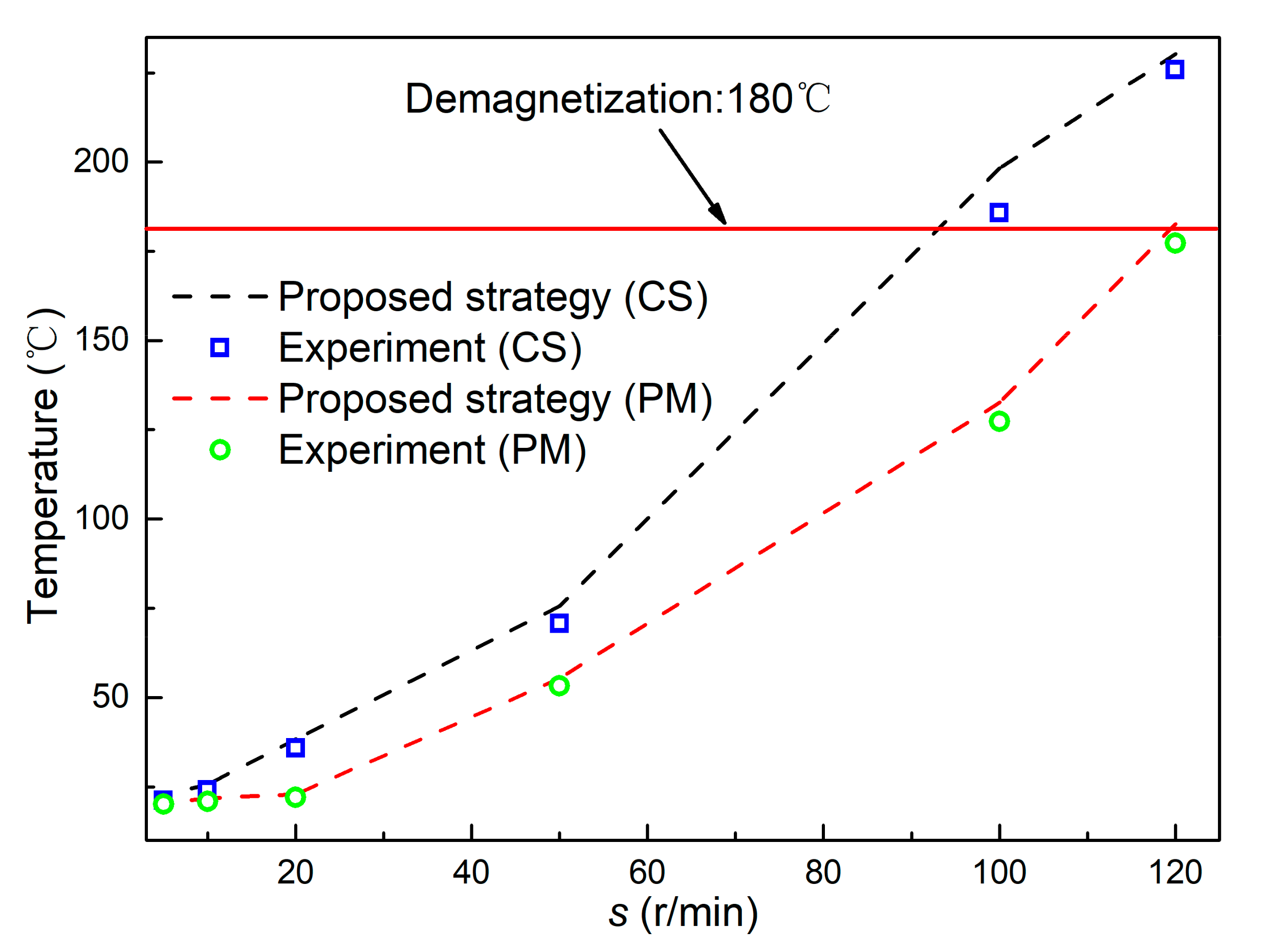
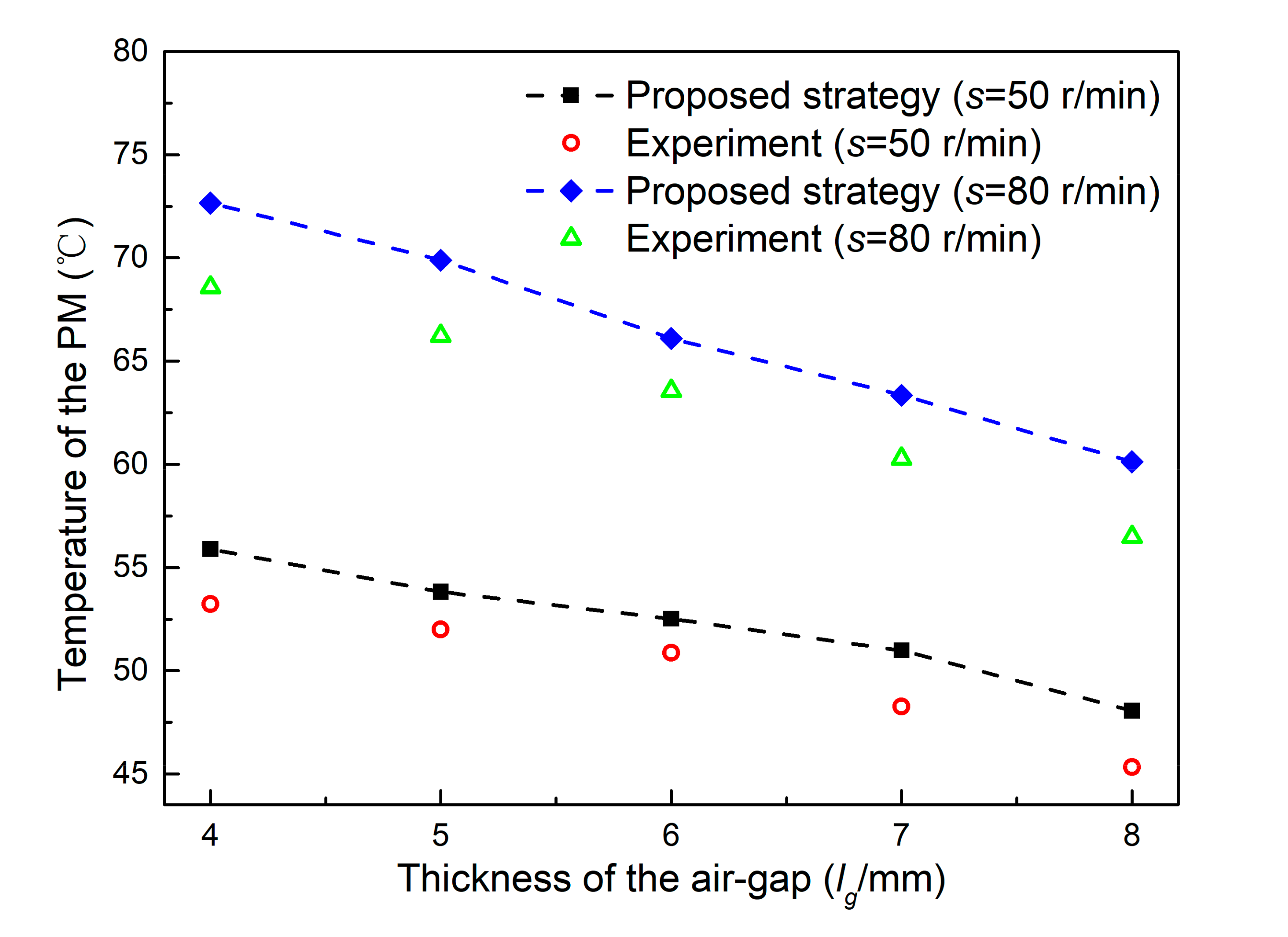
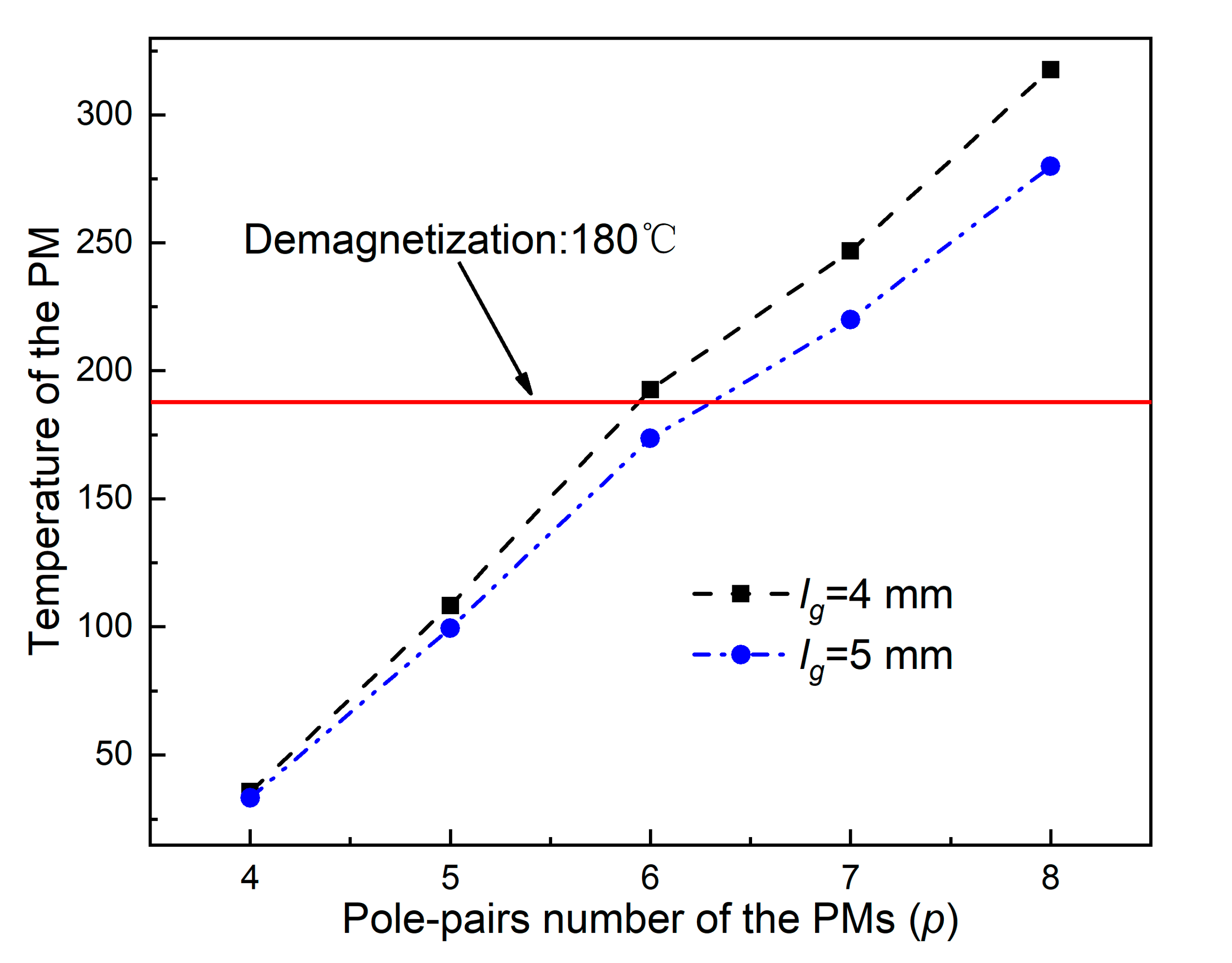
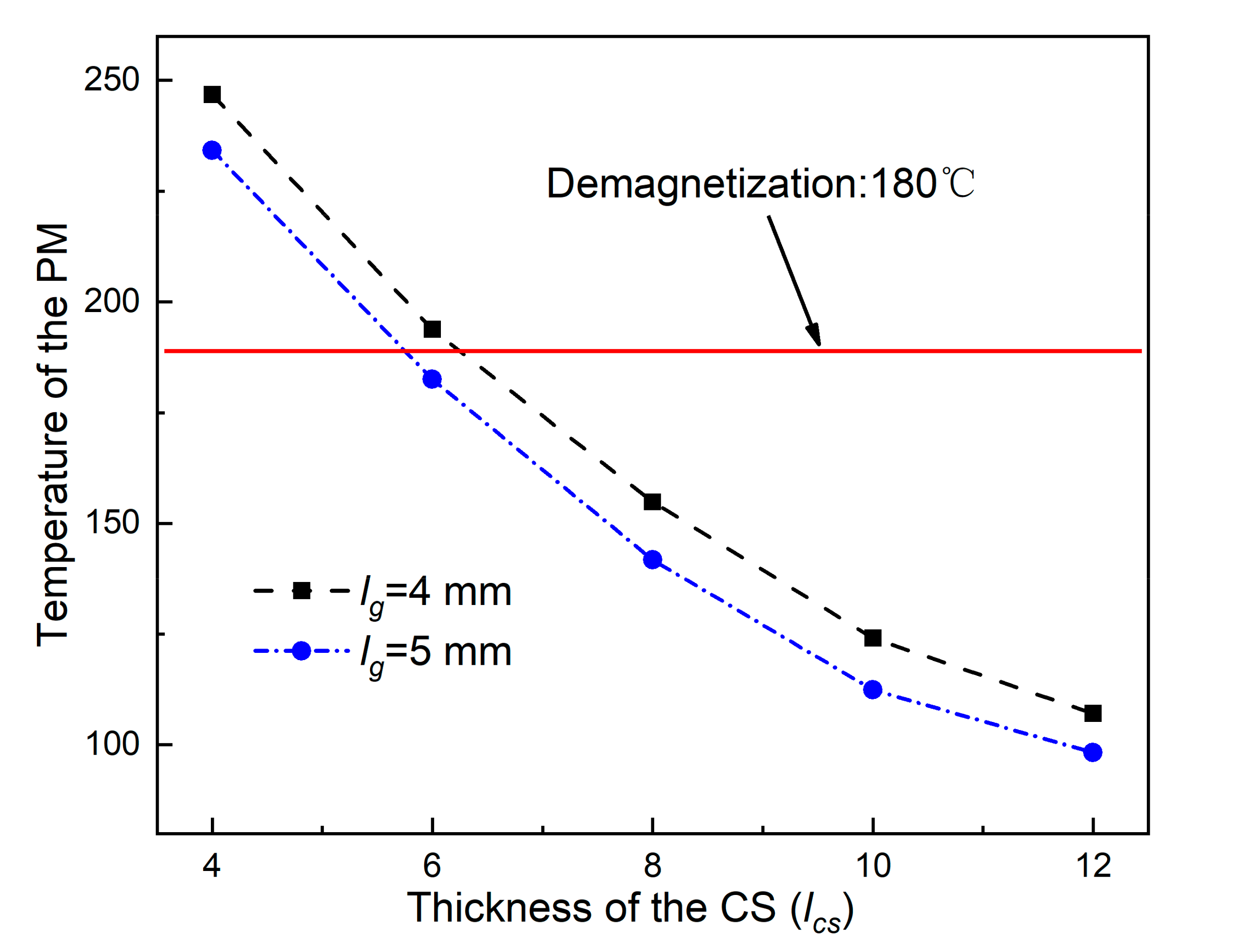
| Symbol | Meaning | Value |
|---|---|---|
| li1 | Thickness of the iron yoke (CS side) | 10 mm |
| li2 | Thickness of the iron yoke (PM side) | 10 mm |
| lcs | Thickness of the CS | 6 mm |
| lg | Thickness of the air-gap | 3–8 mm |
| lh | Thickness of the PM holder | 26 mm |
| lp | Thickness of the PM | 25 mm |
| r1 | Inside radius of the CS | 87.5 mm |
| r2 | Outside radius of the CS | 187.5 mm |
| rp1 | Inside radius of the PM | 115 mm |
| rp2 | Outside radius of the PM | 165 mm |
| ra | Average radius of the PM | 140 mm |
| Hp | Coercive force of the PM | −900 KA/m |
| σcs | Conductivity of the CS | 5.8 × 107 S/m (20 °C) |
| Material | Symbol | Value (W/(m·°C)) |
|---|---|---|
| Steel | kst | 36 |
| Copper | kcop | 390 |
| Aluminum | kal | 237 |
| Nd-Fe-B | knd | 9 |
| Air | ka | 0.026 |
© 2020 by the authors. Licensee MDPI, Basel, Switzerland. This article is an open access article distributed under the terms and conditions of the Creative Commons Attribution (CC BY) license (http://creativecommons.org/licenses/by/4.0/).
Share and Cite
Cheng, X.; Liu, W.; Tan, Z.; Zhou, Z.; Yu, B.; Wang, W.; Zhang, Y.; Liu, S. Thermal Analysis Strategy for Axial Permanent Magnet Coupling Combining FEM with Lumped-Parameter Thermal Network. Energies 2020, 13, 5019. https://doi.org/10.3390/en13195019
Cheng X, Liu W, Tan Z, Zhou Z, Yu B, Wang W, Zhang Y, Liu S. Thermal Analysis Strategy for Axial Permanent Magnet Coupling Combining FEM with Lumped-Parameter Thermal Network. Energies. 2020; 13(19):5019. https://doi.org/10.3390/en13195019
Chicago/Turabian StyleCheng, Xikang, Wei Liu, Ziliang Tan, Zhilong Zhou, Binchao Yu, Wenqi Wang, Yang Zhang, and Sitong Liu. 2020. "Thermal Analysis Strategy for Axial Permanent Magnet Coupling Combining FEM with Lumped-Parameter Thermal Network" Energies 13, no. 19: 5019. https://doi.org/10.3390/en13195019
APA StyleCheng, X., Liu, W., Tan, Z., Zhou, Z., Yu, B., Wang, W., Zhang, Y., & Liu, S. (2020). Thermal Analysis Strategy for Axial Permanent Magnet Coupling Combining FEM with Lumped-Parameter Thermal Network. Energies, 13(19), 5019. https://doi.org/10.3390/en13195019




